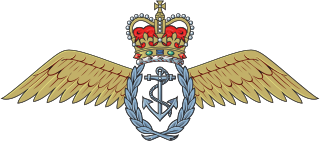
The Fleet Air Arm (FAA) is the naval aviation component of the United Kingdom's Royal Navy (RN). The FAA is one of five RN fighting arms. As of 2023 it is a primarily helicopter force, though also operating the F-35 Lightning II carrier-based stealth fighter jointly with the Royal Air Force.

849 Naval Air Squadron was a squadron of the Fleet Air Arm, the Air Arm of the British Royal Navy. It was formed during the Second World War as a carrier based torpedo-bomber, unit, flying missions against Japanese targets in the Far East. Its service since the Second World War has been as an airborne early warning squadron, flying fixed winged Skyraiders and Gannets from the Royal Navy's fixed wing carriers from 1952 until 1978, and airborne early warning Sea King helicopters from 1982 to 2018.
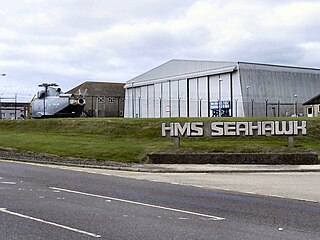
Royal Naval Air Station Culdrose is a Royal Navy airbase near Helston on the Lizard Peninsula of Cornwall UK, and is one of the largest helicopter bases in Europe. Its main role is serving the Fleet Air Arm's front line AgustaWestland Merlin helicopter squadrons.
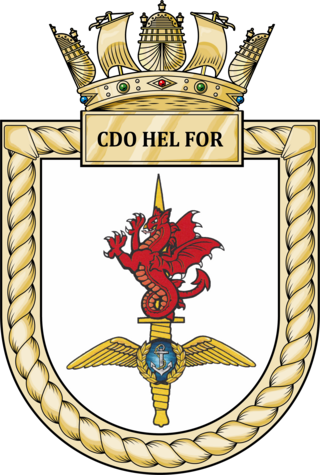
Commando Helicopter Force (CHF) is a unit of the Royal Navy Fleet Air Arm and an element of the Joint Aviation Command of the British Armed Forces. Its primary role is to provide Rotary-Wing support to UK Commando Force and other UK force elements in the amphibious environment. CHF uses a combination of transport helicopters based at Royal Naval Air Station Yeovilton in Somerset, England.
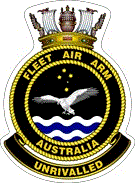
The Fleet Air Arm (FAA), known formerly as the Australian Navy Aviation Group, is the division of the Royal Australian Navy (RAN) responsible for the operation of aircraft. The FAA was founded in 1947 following the purchase of two aircraft carriers from the Royal Navy. FAA personnel fought in the Korean War and the Vietnam War, and participated in later conflicts and operations from host warships.

850 Squadron was a short-lived Royal Australian Navy Fleet Air Arm fighter squadron. Previously 850 Naval Air Squadron had been a Naval Air Squadron of the Royal Navy's Fleet Air Arm. The squadron had been active in 1943 and 1943-1944.
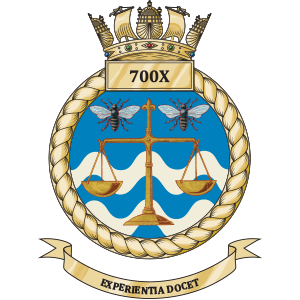
700 Naval Air Squadron is a Fleet Air Arm (FAA) Maritime Unmanned Air System squadron of the United Kingdom’s Royal Navy (RN). Known as 700X Naval Air Squadron, where the 'X' is used to designate 'experimental', it is currently the Royal Navy's Remotely-piloted air systems (RPAS) or 'drone' expert unit.

857 Naval Air Squadron, was a Fleet Air Arm (FAA) naval air squadron of the United Kingdom’s Royal Navy (RN). It was established at Squantum in the United States as a Torpedo Bomber Reconnaissance squadron in April 1944. It boarded HMS Rajah in June, landed in HMS Gadwall, RNAMY Belfast, Northern Ireland, in July, with anti-submarine training at HMS Landrail, RNAS Machrihanish, Argyll and Bute, Scotland. The squadron re-embarked in September for Ceylon, spending time on land at HMS Garuda, RNARY Coimbatore, India and HMS Ukussa, RNAS Katukurunda, Ceylon, before boarding HMS Indomitable in November. Throughout the winter, using the carrier and HMS Nabbington, RNAS Nowra, Australia as a shore base, the squadron targeted locations in Sumatra, including Palembang, before shifting focus to Sakashima Gunto and Formosa in the spring. The squadron returned to the Far East after VJ-Day to engage Japanese suicide boats off Hong Kong. After leaving its aircraft in Australia, the squadron returned home and was disbanded in November 1945.

815 Naval Air Squadron is a Royal Navy Fleet Air Arm squadron flying the AgustaWestland Wildcat HMA.2 helicopter and is the Navy's front line Wildcat Naval Air Squadron. The squadron is based at RNAS Yeovilton in Somerset. The squadron is capable of carrying out multiple roles such as: counter-narcotics, anti-piracy, Above Surface Warfare (ASuW), search and rescue, disaster relief and flying and engineering training. In the early 2000s, the Navy said that the squadron was largest helicopter squadron in Europe.
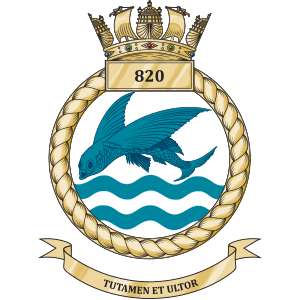
820 Naval Air Squadron is a Royal Navy Fleet Air Arm carrier-based squadron flying the AgustaWestland Merlin HM2 in Anti-Submarine and Airborne Early Warning (AEW) roles from RNAS Culdrose.
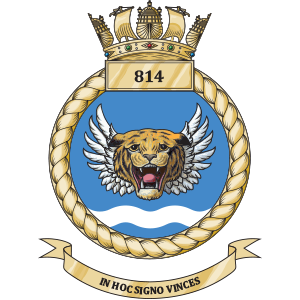
814 Naval Air Squadron or 814 NAS, nicknamed the Flying Tigers, is a squadron of the Royal Navy Fleet Air Arm. It is currently equipped with the AgustaWestland Merlin HM2 anti-submarine warfare helicopter and is based at Royal Naval Air Station (RNAS) Culdrose in Cornwall. The squadron was formed in December 1938 and has been disbanded and reformed several times.

834 Naval Air Squadron was a Naval Air Squadron of the Royal Navy's Fleet Air Arm. The squadron was formed in Jamaica in December 1941 as a torpedo bomber squadron equipped with Fairey Swordfish aircraft. The squadron was embarked on HMS Archer from March 1942 to February 1943 and involved in convoy escorted duties in the Atlantic and Mediterranean. 834 NAS then joined No. 19 Group RAF Coastal Command for duties in the English Channel. In June a flight of Supermarine Seafires was formed and the next month the squadron was embarked on HMS Hunter. The squadron took part in the Salerno landings in September, before being transferred to HMS Battler to provide convoy escort duties in the Indian Ocean. 834 NAS received a further flight of 6 Wildcat Vs in April 1944 and the Seafire flight was disbanded in July. The squadron returned to the UK in November 1944 and was disbanded in December.
877 Naval Air Squadron was a Naval Air Squadron of the Royal Navy's Fleet Air Arm. The squadron formed at Tanga, Tanganyika Territory in April 1943 as a Fleet Fighter unit for local defence duties, using RAF Hurricane IIBs. In July 1943 the squadron moved to Port Reitz, Mombasa with the intention to fly with long-range fuel tanks to the defence of Ceylon but this was cancelled and the squadron disbanded in December 1943.

886 Naval Air Squadron was a Naval Air Squadron of the Royal Navy's Fleet Air Arm. It was formed at HMS Merlin, RNAS Donibristle, as a Fleet Fighter squadron during March 1942. The squadron was loaned to RAF Fighter Command during the summer of 1942, returning the Fleet Air Arm later on in the year. 1943 saw it participate in Operation Avalanche, part of the Allied invasion of Italy. The following year it was involved with operations over Normandy, spotting for the allied invasion of France from 6 to the end of June 1944, disbanding the following month.

887 Naval Air Squadron was a Naval Air Squadron of the Royal Navy's Fleet Air Arm, which last disbanded during March 1946. It was formed as a Fleet Fighter squadron in May 1942 at HMS Daedalus, RNAS, Lee-on-Solent. The squadron embarked in HMS Unicorn during 1943 for convoy escort duties and later in the year to cover the allied landings at Salerno, Italy. At the end of 1943 it formed part of the 24th Naval Fighter Wing. 1944 saw it embark in HMS Indefatigable and the squadron saw action in operations against the german battleship Tirpitz during early 1944 and then joined the British Pacific Fleet at the end of the year. It was part of the attacks on the oil refineries at Palembang at the start of 1945 and later in the year it was involved in sorties around Tokyo, as part of the 7th Carrier Air Group, before V-J Day.
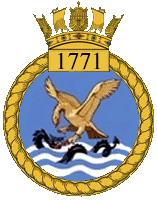
1771 Naval Air Squadron was a Naval Air Squadron of the Royal Navy's Fleet Air Arm which disbanded at HMS Nabbington, RNAS Nowra, near Sydney, in October 1945. Notably, the squadron was the first British & Commonwealth unit to fly over Japan in the Second World War. The squadron formed at HMS Heron, RNAS Yeovilton at the start of February 1944, as a Fighter Squadron and also operated from HMS Ringtail, RNAS Burscough, and HMS Landrail, RNAS Machrihanish, with deck landing training on the escort carriers HMS Trumpeter and HMS Ravager before embarking in the fleet carrier HMS Implacable in September. It was involved in sorties over Norway including reconnaisance of the German battleship Tirpitz and other anti-shipping strikes. The squadron remained in HMS Implacable and joined the British Pacific Fleet participating in attacks on the Caroline islands and the Japanese home islands, and becoming part of the 8th Carrier Air Group.
1843 Naval Air Squadron was a Fleet Air Arm (FAA) naval air squadron of the United Kingdom’s Royal Navy (RN) between 1943 and 1945 and then a Royal Naval Volunteer Reserve Air Squadron from 1953 to 1957. It formed in the United States at RN Air Section Brunswick, in May 1944, as a fighter squadron. It arrived in the UK aboard HMS Trouncer in August. Based at HMS Gannet, RNAS Eglinton, Northern Ireland and training at HMS Wagtail, RNAS Ayr, Scotland, the squadron had deck landing training aboard HMS Patroller in December, before joining HMS Arbiter in February 1945, as part of the 10th Naval Fighter Wing. Sailing to Australia, the squadron became part of the 3rd Carrier Air Group, but saw no action before the war ended and disbanded in October 1945. It reformed as a Royal Naval Volunteer Reserve Air Branch anti-submarine squadron, in the Scottish Air Division, from 1953 and disbanded in 1957.

1845 Naval Air Squadron was a Fleet Air Arm (FAA) naval air squadron of the United Kingdom’s Royal Navy (RN). It formed at RN Air Section Brunswick, United States, in June 1944 as a fighter squadron, with eighteen Vought Corsair Mk III fighter aircraft. It embarked in HMS Puncher on 30 August, disembarking to HMS Gannet, RNAS Eglinton, Northern Ireland, on 18 September and joining the 10th Naval Fighter Wing. It re-equipped with twenty-four Vought Corsair Mk IV, and embarked HMS Slinger in December, sailing for the British Pacific Fleet, the squadron was disbanded in April 1945, and its aircraft and personnel absorbed into squadrons aboard the aircraft carriers HMS Formidable and HMS Victorious. On 1 June it reformed in Australia as a single seater fighter squadron at HMS Nabsford, RNAMY Archerfield, Queensland, and it shortly later became a spare squadron in the 3rd Carrier Air Group at HMS Nabbington, RNAS Nowra, New South Wales. With the end of the Second World War the squadron disbanded on 24 October.















